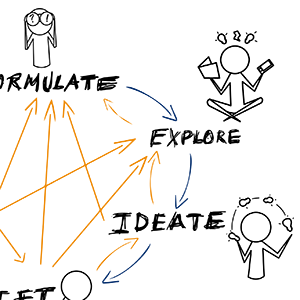 The engineering design process is a set of steps for creating that which does not yet exist. Help your students develop thoughtful solutions to open-ended problems, no matter what the subject area. Design authentic, open-ended problems for your students to solve using IDE Corp.’s Design Process.
The engineering design process is a set of steps for creating that which does not yet exist. Help your students develop thoughtful solutions to open-ended problems, no matter what the subject area. Design authentic, open-ended problems for your students to solve using IDE Corp.’s Design Process.
Syllabus
- Understanding the “place” of design process as creating that which does not exist (referencing the STEM science/engineering juxtaposition but realizing that the IDE Design Process can be used in all subjects)
- Exploring the difference between convergent and divergent thinking
- Understanding the six steps to the IDE Design Process (formulate, explore, ideate, sift, simulate, advocate)
- Understanding the importance of empathy in the IDE Design Process>
- Engaging students in activities that require them to use the design process
- Understanding the importance of efficacy in the classroom
- Exploring the importance of consensus in decision-making and the tools students can use to achieve consensus
Access to MyQPortal is included for all participants while enrolled in the VLC. 25 contact hours.





 In this course, participants will leverage choice and technology to provide students with the ultimate differentiated learning environment. They will develop differentiated digital activity lists rooted in rigorous instruction that offer multiple ways to learn and apply content. Participants will explore autonomy, purpose, and mastery as motivators in all learning environments. They will design differentiated activity lists to put students in charge of their own learning, creating a structure that allows students to make decisions within a structured framework. Making informed decisions is an essential life skill that teachers can support with intentional classroom practices.
In this course, participants will leverage choice and technology to provide students with the ultimate differentiated learning environment. They will develop differentiated digital activity lists rooted in rigorous instruction that offer multiple ways to learn and apply content. Participants will explore autonomy, purpose, and mastery as motivators in all learning environments. They will design differentiated activity lists to put students in charge of their own learning, creating a structure that allows students to make decisions within a structured framework. Making informed decisions is an essential life skill that teachers can support with intentional classroom practices. Participants in this course will use Reinventing the Classroom Experience by Dr. Nancy Sulla as a resource. The assigned book must be
Participants in this course will use Reinventing the Classroom Experience by Dr. Nancy Sulla as a resource. The assigned book must be